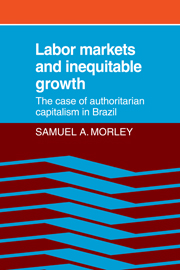Book contents
- Frontmatter
- Contents
- List of tables and figures
- Preface
- Part I Growth, employment creation, and inequality in Brazil
- 1 Introduction
- 2 Production and employment trends in the postwar period
- 3 Rising inequality since 1960
- 4 The meaning and interpretation of rising inequality in a growing economy
- 5 Evidence on absolute improvements and upward mobility
- Part II The effect of supply and demand on labor markets during rapid economic growth
- Data appendix
- Bibliography
- Index
2 - Production and employment trends in the postwar period
Published online by Cambridge University Press: 07 October 2011
- Frontmatter
- Contents
- List of tables and figures
- Preface
- Part I Growth, employment creation, and inequality in Brazil
- 1 Introduction
- 2 Production and employment trends in the postwar period
- 3 Rising inequality since 1960
- 4 The meaning and interpretation of rising inequality in a growing economy
- 5 Evidence on absolute improvements and upward mobility
- Part II The effect of supply and demand on labor markets during rapid economic growth
- Data appendix
- Bibliography
- Index
Summary
Brazil's postwar economic history can be split into four distinct stages: a period of rapid growth based on import substitution from 1949 to 1962, a period of stabilization and slow growth from 1963 to 1967, a period of very fast growth of both domestic industry and exports during the so-called miracle years, 1968 to 1973, and finally a period of slower growth and balance-of-payments (BOP) problems after the oil crisis of late 1973. In this chapter we shall look at regional and sectoral employment and production trends during the first three of these periods. Chapter 11 gathers together the available evidence on what has happened since 1973.
An overview of changes in the structure of employment and output since 1945
Brazil emerged from World War II with a solid basis for subsequent growth. A period of forced import substitution during the depression and the war had created both a strong industrial base and a comfortable level of foreign-exchange reserves. By 1939, domestic industry supplied over 80% of the demand for industrial products, imports only 20%. Import substitution was virtually complete in light consumer nondurables, and even in intermediate goods only 25% of total supply was imported. Only in the basic metal goods and machinery were there substantial imports the postwar period with foreign exchange reserves of $705 million, equal to almost one year of imports. (Baer 1979:62).
The import-substitution period
In the period between 1945 and 1962, very rapid growth was achieved with an inward-looking import-substitution policy, which favored industry and discriminated against agriculture.
- Type
- Chapter
- Information
- Labor Markets and Inequitable GrowthThe Case of Authoritarian Capitalism in Brazil, pp. 18 - 52Publisher: Cambridge University PressPrint publication year: 1983

